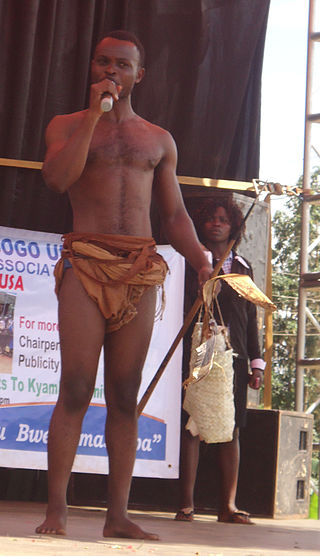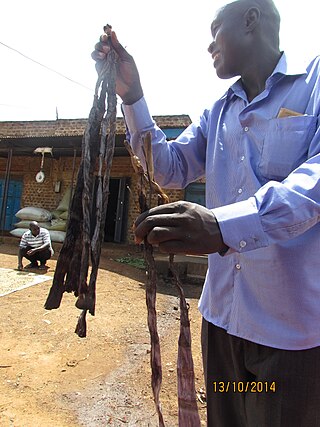Masaba (Lumasaaba), sometimes known as Gisu (Lugisu) after one of its dialects, is a Bantu language spoken by more than two million people in East Africa. The Gisu dialect in eastern Uganda is mutually intelligible with Bukusu, spoken by ethnic Luhya in western Kenya. Masaba is the local name of Mount Elgon and the name of the son of the ancestor of the Gisu tribe. Like other Bantu languages, Lumasaba nouns are divided into several sets of noun classes. These are similar to the genders in Germanic and Romance languages, except that instead of the usual two or three, there are around eighteen different noun classes. The language has a quite complex verb morphology.

The Luhya are a Bantu people and the second largest ethnic group in Kenya. The Luhya belong to the larger linguistic stock known as the Bantu. The Luhya are located in western Kenya and Uganda. They are divided into 20 culturally and linguistically united clans. Once known as the Kavirondo, multiple small tribes in North Nyanza came together under the new name Baluhya between 1950 and 1960. The Bukusu are the largest Luhya subtribe and account for almost 50% of the entire Luhya population, dominating other Luhya subtribes. They live in both Bungoma and Trans-Nzoia counties.

The Bukusu people are one of the 17 Kenyan tribes of the Luhya Bantu people of East Africa residing mainly in the counties of Bungoma and Trans Nzoia. They are the largest tribe of the Luhya nation, with 1,188,963 identifying as Bukusu in the 2019 Kenyan census. They speak the Bukusu dialect.
The Oropom were the aboriginal inhabitants of much of Karamoja in Uganda, Mt. Elgon area and West Pokot, Trans Nzoia and Turkana regions in Kenya. Their descendants were largely assimilated into various communities present in their former territories, including the Iteso, Karamojong, Pokot, Turkana and Bukusu. They are or were found in scattered pockets between the Turkwel River, Chemorongit Mountains and Mt. Elgon. One report indicates that they formerly spoke the unclassified Oropom language.
Bukusu is a dialect of the Masaba language spoken by the Bukusu tribe of the Luhya people of western Kenya. It is one of several ethnically Luhya dialects; however, it is more closely related to the Gisu dialect of Masaaba in eastern Uganda than it is to other languages spoken by the Luhya.

Culture of Uganda is made up of a diverse range of ethnic groups. Lake Kyoga forms the northern boundary for the Bantu-speaking people, who dominate much of East, Central, and Southern Africa. In Uganda, they include the Baganda and several other tribes

The Masaba people, or Bamasaaba, are a Bantu people inhabiting the eastern Ugandan districts of Sironko, Manafwa, Bududa, Mbale, Namisindwa and Bulambuli. They are closely related to the Bukusu and Luhya of Western Kenya. They are mainly agricultural people, farming coffee, millet, bananas and sorghum on small-holder plots. Maize became popular with the coming of Europeans in the late 1890s.

The Maragoli, or Logoli (Ava-Logooli), are now the second-largest ethnic group of the 6 million-strong Luhya nation in Kenya, numbering around 2.1 million, or 15% of the Luhya people according to the last Kenyan census. Their language is called Logoli, Lulogooli, Ululogooli, or Maragoli. The name Maragoli probably emerged later on after interaction of the people with missionaries of the Quaker Church.

The Tachoni is one of the tribes that occupy the western part of Kenya,its known for its gallant defense of the Chetambe in 1895 when resisting British rule. Tachoni people were masters at building forts such as Chetambe, Lumboka, and Kiliboti. It was their defiance of colonialism that led to the colonial government putting the entire region occupied by the Tachoni under administration of paramount chiefs drawn from Bunyala and Wanga communities. Sharing land with the Abanyala, the Kabras, Nandi, and Bukusu tribe. They live mainly in Webuye, Chetambe Hills, Ndivisi Matete sub-county-Lwandeti, Maturu, Mayoyo, Lukhokho, Kiliboti, Kivaywa, Chepsai, and Lugari sub-county in Kakamega County. Most Tachoni clans living in Bungoma speak the ' Olutachoni dialect which is a hybrid of the luhyia language of the luhyia people. Since they lost their original dialect during the divide and rule system used by the whites to scatter them for being resistants to their colonialism, they had to find a way to interact with their new neighbors and thats why they're subsequently mistaken as Bukusus. They spread from Kakamega county to Trans-Nzoia County, webuye especially around Kitale, Tambach in Iten Nandi in areas like kabiyet and kapsisiwa, kericho and to Uasin Gishu County near Turbo, Eldoret.
Among the Tachoni clans are Abachikha -further divided into Abakobolo, Abamuongo, Abachambai,Abamakhanga, Abacharia, and Abakabini, Abamarakalu, Abangachi -who are further divided into: Abawaila, Abakhumaya and Abawele, Abasang'alo, Abasamo, Abayumbu, Abaluu, Abarefu,Abanyangali, Abamuchembi, Abamakhuli, Abasioya, Abaabichu,Abacheo, Abamachina,Abaengele, Abamutama, Abakafusi, Abasonge, Abasaniaka, Abaabiya also known as Abakatumi, Abakubwayi,Abakamutebi, Abakamukong, Abamweya, Abalukulu,Abawande, Abatukiika, Abachimuluku. Note that the morpheme 'aba' means 'people'.

The Khayo is a sub tribe of the Luhya people of Kenya. They reside in Busia County, by the Kenya-Uganda border. Their Luhya neighbors are the Samia, Marachi, Wanga and Bukusu. The Bakhayo border the Bukusu on the East, the Republic of Uganda and Samias on the West, the Marachi on the South and the Wanga on the South East. On their north, they are bordered by the Iteso, a non-Luhya Nilotic people of Kenya.
Bugisu sub-region is a region in Eastern Uganda that consists of the following districts:

Malewa is smoked bamboo shoot which is dried for preservation. The bamboo trees grow in the wild in eastern Uganda around Mt. Elgon in the districts of Bududa, Sironko and Mbale.
Circumcision in Africa, and the rites of initiation in Africa, as well as "the frequent resemblance between details of ceremonial procedure in areas thousands of kilometres apart, indicate that the circumcision ritual has an old tradition behind it and in its present form is the result of a long process of development."

The Sabaot are one of the nine sub-tribes of the Kalenjin of Kenya and Uganda. The Sabaot in turn are divided into six sub-tribes largely identified by their dialects. These dialects of the Sabaot language are the Pok, Somek, Mosop, Koony, Bong'omek and Sabiny. Being resident around Mount Elgon, the original homeland of most Kalenjin, the Sabaot are seen as the keepers of the authentic Kalenjin tradition. They and the area they inhabit are often referred to as Kapkugo by other Kalenjin.

Imbalu is a public circumcision ceremony practiced by the Bamasaba people of Uganda. It takes place at the Mutoto cultural site near Mbale in eastern Uganda. It is mostly active in the 8th month of every even year. The ground is believed to be the place where the first Mugishu (Mumasaba) was circumcised. This community affair is characterized by dance and food. The ceremony has been heavily promoted as a tourist attraction, and tens of thousands of people attend. Imbalu marks the initiation of boys into manhood and every year, hundreds of boys aged 16 and above qualify for the Imbalu. In 2022, about 6,000 boys were initiated into manhood during the cultural ceremony that happens every year. This is because the ceremony had not happened ever since 2020 when Uganda was locked down due to the outbreak of COVID-19 pandemic.

Bukedi District was a subdivision of the Eastern Province of the Uganda Protectorate, with headquarters in Mbale. In the early 1920s Bukedi was divided into the Budama, Bugisu and Bugwere districts. These were recombined into Mbale District during World War II (1939–1945), then split in 1954 into a new, smaller Bukedi District to the west and Bugisu District to the east, sharing Mbale Township as their administrative headquarters. In 1968 the administrative headquarters of Bukedi District were moved to Tororo. Later Bukedi District was split up into a number of smaller districts.

The Banyole or Banyuli are a Bantu ethnic group of Uganda that live mainly in Butaleja District.
Nabumali is a village in Mbale District in eastern Uganda. It is known for its high school, which is over 100 years old.

Ugandan folklore includes traditional folktales and other folklore from the African country of Uganda. The convey meaning and experiences from generation to generation. Traditionally, folktales instilled discipline and good behaviour that shaped societal beliefs and norms within Ugandan society.
Kadodi dance is a traditional dance performed by the Bamasaba people, also known as the Bagisu or the Gishu, who live in the eastern part of Uganda and the western part of Kenya. Kadodi dance is mainly associated with the Imbalu the male circumcision ceremony that marks the transition from boyhood to manhood among the Bamasaba. Kadodi dance is also performed at other occasions, such as weddings, festivals, and cultural events.











